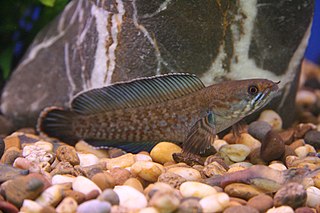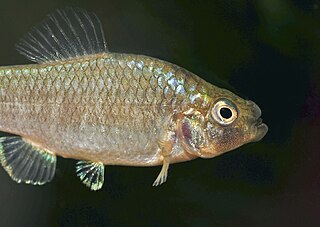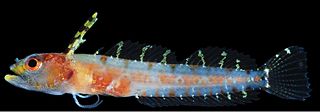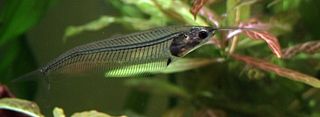 W
WAetobatus narutobiei, the Naru eagle ray, is a species of cartilaginous fish of the eagle ray family, Myliobatidae. It is found in the northwest Pacific off south Japan, South Korea, China, Hong Kong and Vietnam. It occurs from shallow, coastal flats to a depth of 59 m (194 ft), but always in water warmer than 15 °C (59 °F).
 W
WArapaima leptosoma is a species of freshwater fish endemic to near the confluence of the Solimões and Purus Rivers in Amazonas, Brazil. Like other members of the genus Arapaima, this fish can breathe air. It has a deep caudal peduncle relative to other species in its genus. It is the first new member of Arapaima to be described since 1847. Member species of the genus Arapaima are the largest freshwater fish in South America.
 W
WChanna andrao is a species of snakehead, a fish of the family Channidae. Its range includes India in Asia. It is described in 2013 by Ralf Britz. The species name honours Andrew Rao.
 W
WCyprinodon brontotheroides is a species of pupfish in the genus Cyprinodon. It is endemic to hypersaline interior lakes on San Salvador Island, Bahamas. It coexists alongside two other closely related Cyprinodon species C. desquamator and C. variegatus. Together, these three species represent a recent adaptive radiation, each having moved into a difference niche within their specialized environment. Each of these species are defined by distinct trophic adaptations that have affected various aspects of functional morphology.
 W
WCyprinodon desquamator is a scale-eating species of pupfish in the genus Cyprinodon. It is endemic to hypersaline interior lakes on San Salvador Island, Bahamas. It coexists alongside two other closely related Cyprinodon species C. brontotheroides and C. variegatus. Together, these three species represent a recent adaptive radiation, each having moved into a difference niche within their specialized environment. Each of these species are defined by distinct trophic adaptations that have affected various aspects of functional morphology.
 W
WHemiscyllium halmahera, or the Halmahera epaulette shark, is a species of bamboo shark from Indonesia. This species is described from two specimens collected near Ternate island in 2013, off the coast of larger Halmahera island. This species is most similar to Hemiscyllium galei, found in West Papua, but looks strikingly different in its pattern of spots. While H. galei has seven large, dark spots on each side of its body, H. halmahera has a brown color with clusters of brown or white spots in polygon configurations all over its body. These small sharks are like other bamboo sharks, in that they use their pectoral fins to "walk" along the ocean floor.
 W
WHaplochromis argens is a species of haplochromine cichlid endemic to Lake Victoria where it is only known from the Tanzanian portion. This species reaches a length of 7.6 centimetres (3.0 in) SL. It feeds on zooplankton.
 W
WHaplochromis goldschmidti is a species of cichlid endemic to Lake Victoria, where it is only known to occur with certainty in the southern part of the Emin Pasha Gulf. It feeds mainly on zooplankton and some insects. This species can reach a length of 6.9 centimetres (2.7 in) SL. The specific name honours the Dutch evolutionary biologist Paul-Tijs (Tijs) Goldschmidt who he studied cichlids in Lake Victoria as a researcher from Leiden University.
 W
WHaptoclinus dropi, the Four-fin blenny, is a species of labrisomid blenny only known to occur off of Curaçao in the Caribbean where it was collected from a deep-sea reef at a depth between 157 and 167 metres. The only specimen collected, a female, measured 2.15 centimetres (0.85 in) SL.
 W
WKryptopterus vitreolus, known in the aquarium trade traditionally as the glass catfish and also as the ghost catfish or phantom catfish, is a small species of Asian glass catfish. It is commonly seen in the freshwater aquarium trade, but its taxonomy is confusing and was only fully resolved in 2013. It is endemic to Thailand, and found in rivers south of the Isthmus of Kra that drain into the Gulf of Thailand and river basins in the Cardamom Mountains. There are also unconfirmed reports from Penang in Malaysia.
 W
WLana's sawshark or the Philippine sawshark, is a sawshark of the family Pristiophoridae, found in the Philippines off Apo Island and southern Luzon at depths of between 230 and 590 m. Its length is up to 73 cm.
 W
WThe Manyas spirlin is a species of minnow that is endemic to the Simav River drainage of Lake Kuş, also known as Lake Manyas, in Turkey. It may become threatened as its range is densely inhabited and increasingly industrialized.
 W
WNosferatu molango, also known as Atezca Cichlid, is a species of cichlid endemic to the "Laguna Atezca", in the headwaters of the Rio Moctezuma, in the municipality of Molango, state of Hidalgo, Mexico at 1,270 meters above sea level. It is distinguished from other species of the genus in "having a slender, well-spaced, unicuspid and conical, posterior slightly flattened, indented lower pharyngeal plate, with 2 rows of 8–9 medium-sized, lightly pigmented molars that flank the midline; 11–13 nonenlarged conic teeth along the posterior margin. Distinguished from all other species in the genus by a combination of the following characters: predorsal contour deep and nonacute, which is not concave before the eye; head short, rostral tip to the pectoral fin origin distance ; caudal peduncle short and deep, long anal fin ; wide preorbit ; eye small. Peritoneum is uniformly very dark."
 W
WNosferatu pame, previously placed in the genus Herichthys, also known as labridens 'white' or mojarra caracolera blanca in Spanish, is a species of cichlid "endemic to the main stem and tributaries of the Rio Gallinas, including Rio Tamasopo, Ojo Frío, and Agua Buena, upriver from the Tamul cascade" in the Pánuco River Basin, San Luis Potosí, Mexico.
 W
WNosferatu pratinus, also known as green labridens or mojarra caracolera verde in Spanish, is a species of cichlid "endemic to the Rio el Salto,in the Rio Pánuco Basin in Mexico. The river runs through the Sierra La Colmena, where a series of pools and cascades called “Micos” occur. The area includes seven cascades with heights of five meters or more. Up the river is a town called El Naranjo, which is 102 km north from Ciudad Valles at the border between the States of Tamaulipas and San Luis Potosí. Two kilometers upstream from El Naranjo exists a series of pools and cascades, such as El Salto and El Meco, which are 70-m and 35-m high, respectively; both sites are inhabited by H. pratinus."